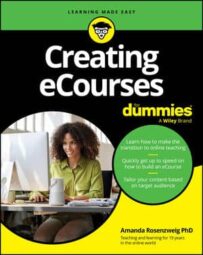Types of eCourses
Any type of eCourse can end with a certificate being awarded by an accredited organization or a professional business. eCourses are typically structured as one of the following three types:
- Synchronous courses: Students have the flexibility to take these courses from anywhere, but live meetings are an integral part of the program. Students are required to attend these meetings via phone, web platforms, or in person. Often there are preset meeting times that students will be made aware of prior to enrolling. Some instructors will survey students for the best meeting times, and others will offer a few options for all students to choose from and attend as they can.
- Asynchronous courses: These courses don’t entail any planned live interaction with the instructor or peers. They are self-paced and provide material to review and assignments to complete for students to achieve their goals. The course may be chunked into learning units or modules with due dates throughout the length of the course, or there may be just one due date, at the end of the course. Some courses may have no due date at all but rather are purchased for lifetime access.
- Hybrid courses: These courses are a combination of synchronous and asynchronous work. The institution, company, or teacher determines how the course is delivered.
Checking the accessibility of your eCourse
Many of the tools you will use to build content for your eCourse have an accessibility checker built in, which is great. But realize that no accessibility checker will be able to evaluate a document completely without human touch. The tools cannot emulate human attributes such as context and common sense.
The following is a list of some free tools that are available to check different aspects of accessibility:
- Web Accessibility Versatile Evaluator (WAVE) is an evaluation tool that identifies many accessibility WCAG errors and helps humans evaluate the website. WAVE can be used as a plug-in, or a website URL can be directly placed in the website’s search bar. Consider using the WAVE tool on a website you use daily and look at the accessibility reports.
- Accessibility Checker is an audit tool that checks websites for major errors based on legislation around the world. The scans provide detailed reports on each error, whom it affects, and how to resolve the issues.
- PAVE is a PDF web tool that helps fix existing PDF documents with tagging documents for use with assistive technology.
- Universal Design Online Inspection Tool (UDOIT) allows faculty to identify web accessibility issues in the Canvas Learning Management System. UDOIT is free by downloading the source code at UDOIT’s GitHub page.
- Accessibility Color Wheel helps you choose color pairs (text and background). It simulates three types of color blindness and uses contrast checkers.
- Microsoft Accessibility Checker uses a set of rules to identify many issues that may affect people with disabilities use of a file. The accessibility checker can provide information on the issues and potential ways to fix them.
- Adobe Accessibility Checker is present in Acrobat Pro, and it helps review common WCAG standards. The tool allows you to check accessibility and can guide you on how to fix issues such as reading order and structure.

